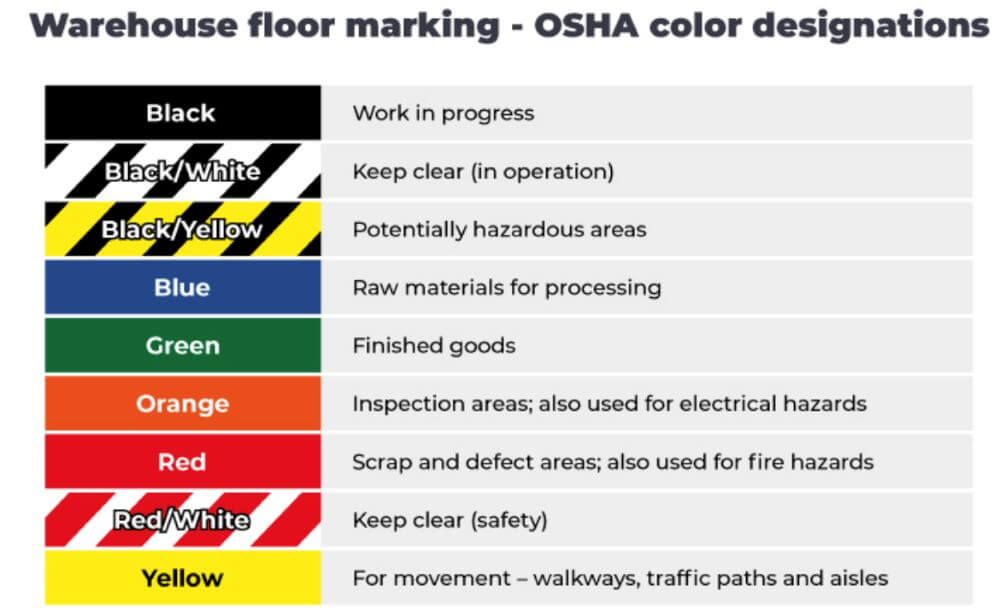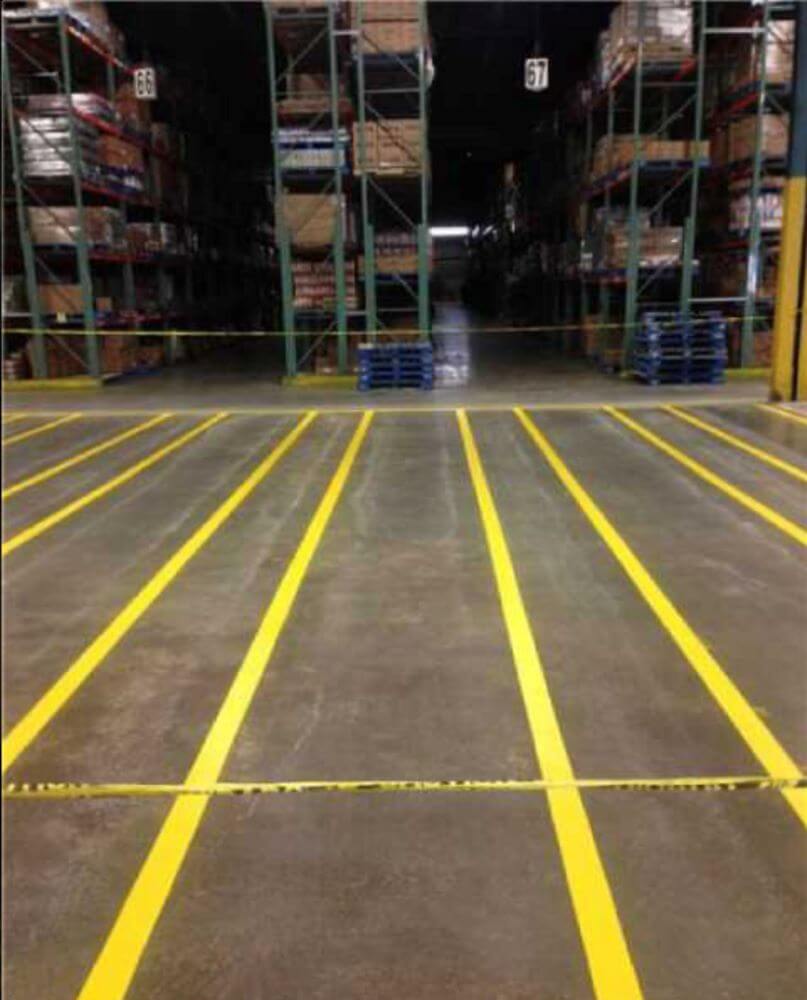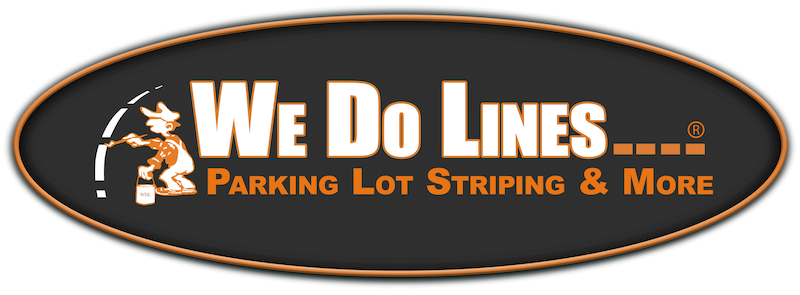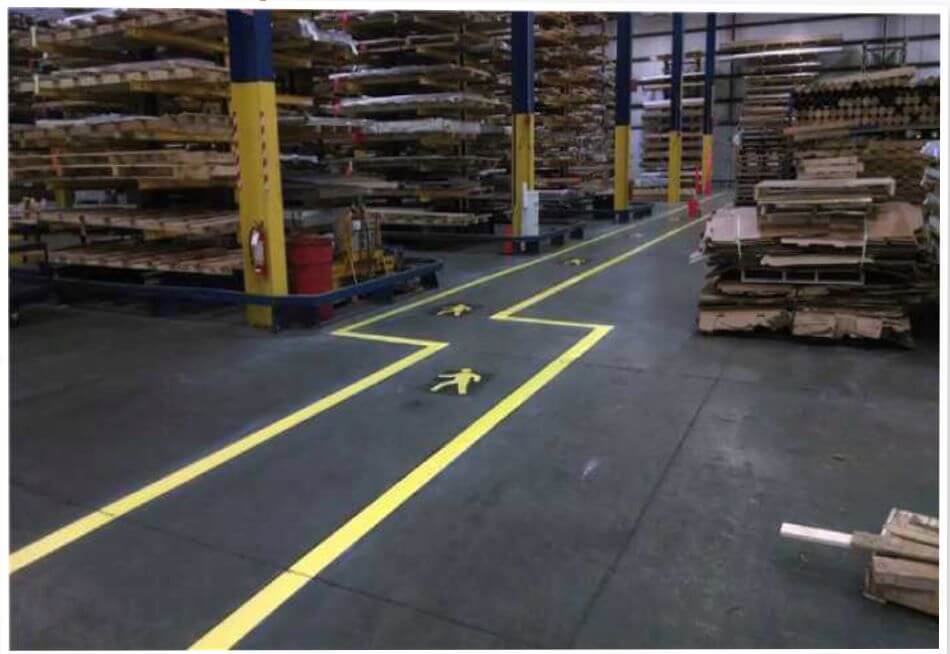In the dynamic industrial landscape of Arizona, where the blend of bustling warehouse activities and extreme environmental conditions presents unique challenges, adherence to Occupational Safety and Health Administration (OSHA) standards for warehouse striping is not just a regulatory requirement but of critical safety and efficiency importance. This article examines the OSHA guidelines for warehouse striping, the specific standards and specifications, the unique requirements for Arizona, the challenges encountered, and the overarching role of striping in promoting a safer and more efficient workplace.
Overview of OSHA Warehouse Striping Requirements
OSHA’s guidelines for warehouse striping are designed to ensure that workspaces are organized in a manner that promotes safety and efficiency. These guidelines mandate clear, visible floor markings to represent work areas, pathways, and hazardous zones, thereby reducing the risk of workplace accidents and enhancing the flow of operations. Key aspects include the strategic use of color coding, appropriate sizing and placement of markings, and the integration of reflective materials for improved visibility.
Specific Striping Standards and Specifications
Diving deeper, OSHA provides detailed specifications for striping that include minimum width requirements, color standards, and the types of materials that should be used to ensure durability and visibility. These specifics help warehouse operators in Arizona ensure compliance and enhance safety.
Traffic Lanes and Pedestrian Pathways:
- Width: OSHA recommends a minimum width of 2 inches for markings, but wider stripes (4 to 6 inches) are advisable for main aisles or pathways used by vehicles.
- Color: Yellow is the standard color for marking warehouse aisles and pathways, ensuring they stand out against the floor.
Hazardous Areas:
- Marking Hazardous Areas: Areas that contain dangerous materials or pose other risks must be clearly marked. This often involves using red for fire hazards or orange for mechanical hazards.
- Borders: Borders around hazardous areas should be marked with stripes, typically in black and yellow or black and white, to signify caution.
Storage Areas:
- Designation: Storage areas should be clearly defined with striping to indicate where goods should be placed, preventing obstruction of aisles or emergency exits.
- Color Coding: Different colors can be used to categorize storage areas based on the type of goods or to differentiate between shipping and receiving zones.

Equipment and Machinery:
- Marking Around Equipment: Clear zones around machinery and equipment ensure safe operation spaces and prevent unauthorized access.
- Signage: In addition to striping, signage can be used to provide additional information or warnings about machinery operations.
Safety Equipment and Exits:
- Location Marking: Safety equipment, including fire extinguishers, eyewash stations, and first aid kits, should be marked with green. Exits must be clearly marked with red or another distinct color.
- Pathways to Exits: Pathways leading to exits should be free of obstructions and marked in a color that contrasts with the rest of the warehouse floor, typically using the same yellow as for main aisles.
OSHA Standards for Industrial Warehouse Striping in Arizona
Arizona warehouses must comply with federal OSHA standards while also considering state-specific guidelines and environmental factors that might affect the application and maintenance of floor markings. In this context, the Arizona Division of Occupational Safety and Health (ADOSH) plays a crucial role in ensuring that warehouses adhere to these standards, providing resources and guidance tailored to the unique challenges of the Arizona industrial sector.
- Visibility and Color Coding: Markings must be highly visible, with color coding used to signify different areas or purposes. For instance, yellow often denotes caution, indicating areas where workers should be particularly vigilant.
- Width and Thickness: OSHA mandates specific dimensions for striping to ensure that markings are easily distinguishable from a distance. While the agency does not prescribe exact widths, the consensus among safety professionals suggests a minimum of 2 inches wide, with 4 inches being standard for clear visibility.
- Material Durability: Given the high traffic within warehouses, the materials used for striping must withstand wear and tear, ensuring longevity and reducing the need for frequent reapplications.
By adhering to these standards, warehouses in Arizona can create a safer environment for workers, minimizing the risk of accidents and contributing to a more efficient operational workflow.

Compliance Challenges and Solutions in Arizona
Adapting OSHA standards to the unique environmental and operational realities of Arizona presents specific challenges, chiefly due to the state’s extreme temperatures and sunlight exposure. These conditions can degrade striping materials more rapidly than in milder climates, necessitating more frequent maintenance and consideration of material selection.
Challenges:
- Rapid Degradation: The intense Arizona sun can fade markings quickly, reducing their visibility and effectiveness as safety cues.
- Material Wear: High temperatures can also contribute to the faster wear of striping materials, especially in outdoor or semi-outdoor warehouse areas.
Solutions:
- UV-Resistant Paints: Utilizing paints specifically designed to resist UV radiation can significantly extend the lifespan of warehouse floor markings.
- Thermoplastic Markings: For areas exposed to direct sunlight or extreme temperatures, thermoplastic materials offer a durable alternative to traditional paints. These materials not only resist fading but also withstand wear from heavy machinery and foot traffic.
- Regular Maintenance Schedules: Establishing a routine inspection and maintenance schedule ensures that striping remains compliant with OSHA standards and is effective in promoting safety and efficiency. This proactive approach allows for the timely identification and rectification of any issues before they escalate into safety hazards.

The Role of Warehouse Striping in Safety and Efficiency
Beyond compliance, effective warehouse striping plays a pivotal role in enhancing safety and operational efficiency. Clear, well-maintained floor markings guide traffic, define safe walking paths, and alert workers to hazardous areas, significantly reducing the risk of accidents. Furthermore, strategically placed striping can optimize the flow of operations, minimizing bottlenecks and facilitating smoother movement of people and goods within the facility, thereby boosting productivity.
Adherence to OSHA standards for warehouse striping in Arizona is essential for ensuring a safe and efficient workplace. While the unique environmental conditions of Arizona present additional challenges, through careful selection of materials, regular maintenance, and a commitment to compliance, warehouses can overcome these obstacles. Ultimately, the goal is to create a work environment that is not only safe for workers but also conducive to high productivity and operational excellence. By prioritizing the implementation and upkeep of effective striping practices, Arizona warehouses can achieve these objectives, setting a standard for safety and efficiency in industrial operations.


